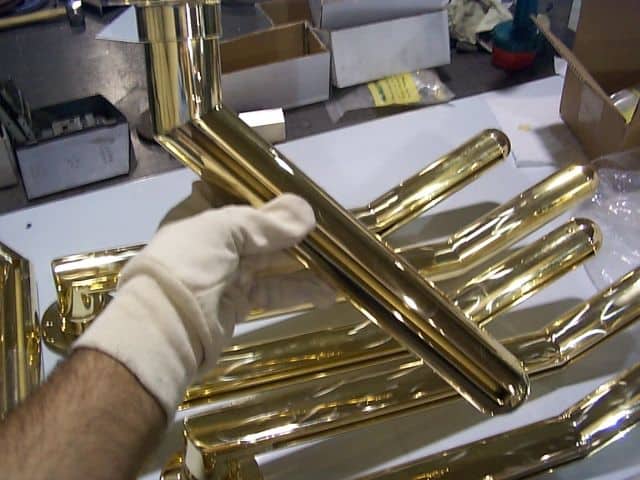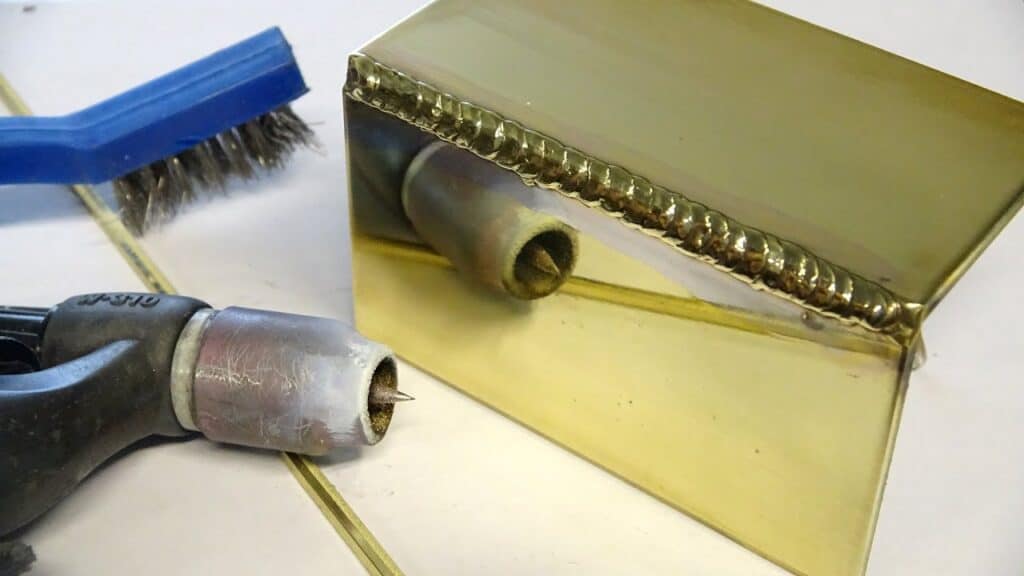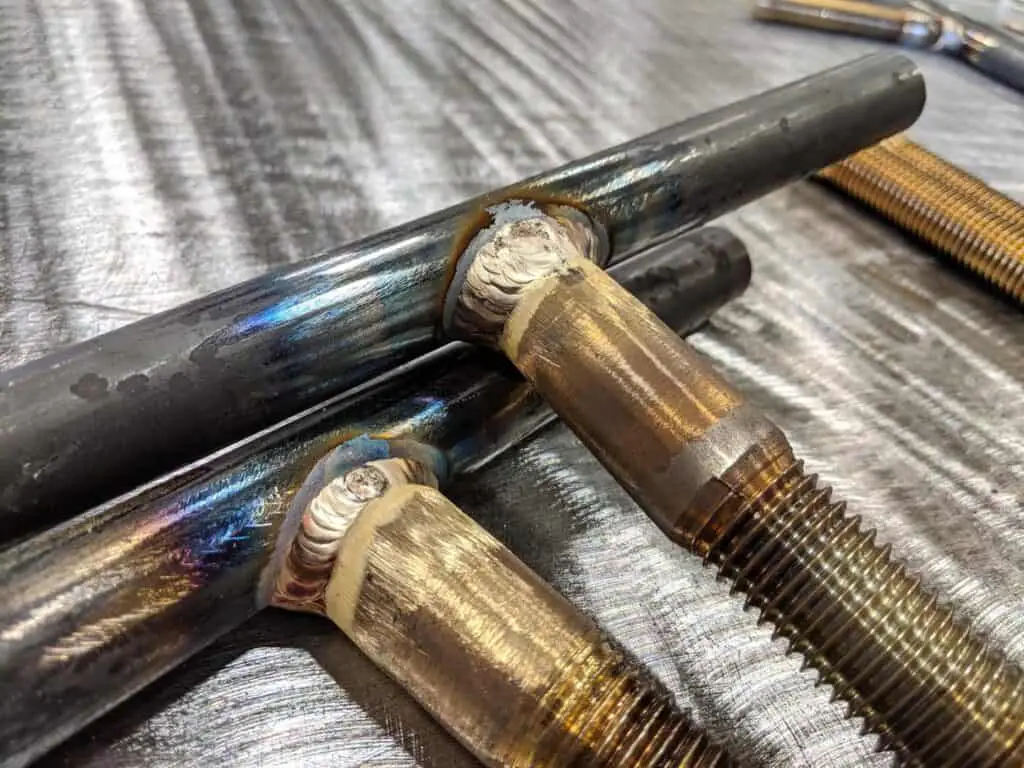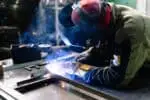Learning how to weld brass is handy for all sorts of low friction applications.
The Lowdown on Brass Welding
The word “brass” is, in reality, a term used to describe zinc and copper alloys. It can be a bit challenging because the amount of zinc will affect the melting point of your brass significantly.
 This attractive metal is used for musical instruments and even more often for decorations that are considered applications in the “low-friction” category.
This attractive metal is used for musical instruments and even more often for decorations that are considered applications in the “low-friction” category.
You will generally find brass’s melting point somewhere between 900° and 940° Fahrenheit, which means it can be cast with various methods successfully.
To weld brass your options include TIG, MIG, and silver soldering. However, make sure to select your shielding gas carefully. This material can become porous and when the alloys separate, it will eventually crack.
Brass has various properties that make it an attractive metal:
-
-
- corrosion resistance
- electrical conductivity
- hardness
- machinability
-
Thanks to its low-friction qualities, brass is regularly used in tools and fittings that may be exposed to explosives or flammable materials and even in ammunition casings. Other uses include valves, plumbing, and electrical needs.
It is highly appreciated in decor and for decorative uses in general because of its attractive golden hue. Its use in many musical instruments is due to its durability and because it is so easy to work with.
All said, however, brass is not the easiest metal to weld.
Safety Precautions for Brass Welding
Zinc tends to spatter, so protective gloves and boots are highly recommended to protect you from burns. The other risk with brass welding is the production of toxic fumes. If you have a fume extractor, this should be used to protect you from toxic gases created during welding.
Ideally, you will need a welding helmet with an auto-darkening feature and good ventilation if you decide to use either TIG or MIG welding procedures. These procedures make use of a very bright arc that can permanently damage eyesight.
Can Brass be Welded to Brass?
Yes, but to create a successful weld, it’s important to know what percentage of zinc is in your brass. Zinc has a lower point for melting than copper, so it’s fundamental that you know before you begin, otherwise you may end up with a porous weld that will crack, leaving you with no weld at all.
You will also need the correct shielding gas. Zinc will interact aggressively with environmental contaminants. It will also produce highly toxic fumes. An Oxyacetylene gas is an effective shield when welding brass. The alternative will again be a porous weld that will not work.

It is recommended that you use flux to assist the fusion of the metals. This particular chemical compound will protect the surface metal from the air in order to prevent oxidation. It will absorb oxides produced during heating as well as oxides not completely removed in cleaning prior to welding.
Mix some flux with water to form a paste and use that paste to coat the surfaces of the brass that you intend to weld. You should also use a braze flux that is appropriate for work with oxyacetylene gas such as white flux.
When you are ready to begin, set your acetylene gas on low while increasing the supply of oxygen. This will enable an oxygen coating for your brass and prevent toxic fumes from escaping during welding.
If you choose to weld brass to brass, use a larger welding tip because you will need more heat conductivity for this process.
See also: Which flame to use to weld brass and bronze
Welding Brass with TIG
While brass as a material offers a high level of thermal conductivity, its zinc component has a very low melting point. One of the risks with TIG welding is that the zinc boils to the point that it latches onto the electrode and interrupts your welding.
If you want to weld brass using the TIG application, our team of pros indicated the use of an AC power inverter with thirty-second pulses would enable welding brass. They also suggested using the absolute minimum heat to start your weld puddle. You should remove the heat every couple of seconds to keep an eye on your pool. This will help you avoid overheating your bass metal.

When finished welding, maintain the argon on the heated area to protect it. The metal must cool off completely. Exposing heated metal to the atmosphere will cause it to become porous and ruin your joint. Once you have produced your join, you will need to grind it off to improve the aesthetic appeal. TIG brass welds are generally not good-looking.
To TIG weld zinc and copper alloys, employ CuSn6 welding rods to improve the color of the weld. Although not an exact match, it will be relatively close. One of the problems with TIG welding of brass is that there is not exact color match. This is true for MIG welding as well.
Welding Brass with MIG
If you choose to do your weld with Metal Inert Gas (MIG), select your filler wire correctly. If the filler wire is not the correct type, it will cause your weld to discolor and potentially ruin your project.
Because zinc and copper are the two principal ingredients in all brass, the better filler wire to keep your weld a desirable color will be CuAI8. This filler wire is made of copper and 8% of aluminum. While the color will not be identical to brass, it will be acceptable.
Finding perfectly matched filler wire for MIG brass welding is all but impossible. The filler wire would have to contain a noteworthy amount of zinc, but zinc burns out at high temperatures, so the idea just is not feasible.
When MIG welding brass, you need a shielding gas that is either pure Argon or Argon and CO2. The Argon and CO2 mix should be 75% Argon and 25% carbon dioxide for good results.
If your shielding gas is not sufficient, your zinc will vaporize. The vapors will consist of zinc oxide that is highly toxic for any welder or person in the vicinity.
Our pro welders indicated that it is a good idea to have a short weld area to reduce any risk of producing zinc oxide fumes. Stitch welding as opposed to continuous welding will help you achieve this. The molten weld will have more time to cool because it will not be exposed to high heat for a continuously long period.
See also: Can you MIG weld without gas
Welding Brass by Flame Welding
If color match is very important to your brass welding project, then the best procedure for attempting to match a color is by flame welding.
If you opt for flame welding, CuZn89Sn filler wire will provide you with pretty good results in terms of color. Three types of primary flames can be utilized when selecting flame welding:
-
-
- Neutral. This type of flame exerts no chemical effect on the piece you are working on.
- Carburizing. This kind of flame will not be suitable if the metals absorb carbon because it will produce iron carbide. For example, this type of flame causes damage in both iron and steel.
- Oxidizing. The oxidizing flame offers more heat than either neutral or carbonizing flames. It is the ideal choice when working with zinc and copper, and this means it is also ideal for brass welding.
-
When you choose to flame weld, you will have to monitor the effect of the flame on the brass constantly to determine how much oxygen you need when welding.
FAQ
Is it easy to weld Brass?
Not really! Unfortunately, zinc and copper are the two principal components of brass. The Zinc will melt much faster than the copper and any other compounds found in the brass, making it a challenge. Also, zinc will react with atmospheric gases and produce zinc oxide.
This gas is exceptionally toxic and hazardous when inhaled. Heat input can ruin the base metal when too high and cause the alloys to separate, so constant heat monitoring is necessary when welding brass.
Is shielding gas important when welding brass?
Very. You need to select a shielding gas that will provide sufficient coverage and thus protect the metal fully. Never turn off the supply of gas until the weld has completely cooled. otherwise, you risk compromising the finished weld with atmospheric contamination resulting in a porous weld that will crack.
Can I MIG weld my brass?
Yes. You must use a mixture of argon and carbon dioxide as a shielding gas, but it can definitely be accomplished. You must also choose the correct filler wire, although a perfect color match is not possible.
When opting for MIG welding for brass, the stitch welding procedure is ideal because it enables you to control heat input and regulate it better.
Can I weld brass to steel?
No, because their welding points are so distant. Brazing will allow you to join the two materials together. The brazing method permits you to join different metals with the assistance of filler metal. In the case of joining brass and steel, a silicon bronze filler rod can be used to join the two metals effectively.
Can I weld brass to aluminum?
No. You need brass to brass.
Can I solder brass without flux?
Yes, as most solder has a rosin core which acts just like flux in breaking down oxides present.
What is the difference between welding and soldering?
Although these two terms are used interchangeably, there is a difference. When soldering, base metals do not require melting. In welding, the base metals will be melted to form the joint. Welding may require 6500°F, whereas soldering can be accomplished at 840°F.
What is the difference between silver soldering and brazing?
Both procedures join metals together through the use of a filler material that fills the joint. This filler material will have a lower melting point than the base metals being joined. The space to be filled will generally be in the range of .002 to .005 inches.
The AWS or American Welding Society defines the difference between the two methods as brazing uses a filler material with a melting point above 840°F, while soldering uses a filler material with a melting point below 840° F.
What type of helmet should I wear when welding brass?
An automatic darkening helmet is the preferred choice for safety purposes particularly if using MIG or TIG welding applications.
A Final Thought
The welding of brass is complicated for any welder with any skill level simply because zinc and copper have such different melting points.
If you know the percentage of zinc in your brass compound, before you begin to weld, and you employ the oxyacetylene procedure, you will be able to weld your brass successfully.
Remember, use safety precautions and PPE, take your time, and get in some practice. In no time at all, you’ll be welding brass like the best of the pros.






